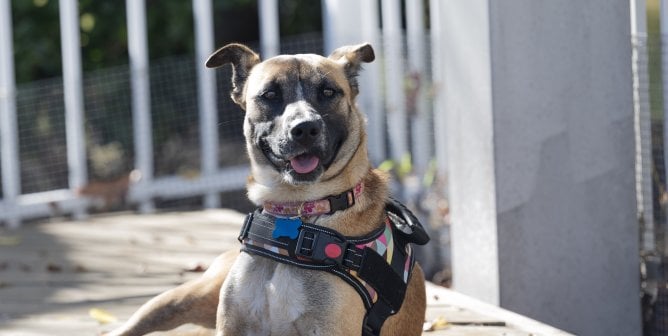Dog training, to me, is about much more than just teaching Fluffy to sit, stay, come, and lie down. It’s about teaching her to feel comfortable and content living in our human culture, and it should be based on dog psychology.
There is no need to be overbearing or mean when working with dogs, but it’s also not good to be too permissive. Dogs need structure and well-defined boundaries, just exactly as children do.
In fact, dog training has a great deal in common with child rearing. Done right, it will foster excellent mental health. But it all starts with a mentally healthy dog guardian, and sometimes we have to work on ourselves in order to help our dogs become well adjusted.
I ran across an article in the Seattle Times recently called “Good Human: 7 Rules for a Happy, Well-Behaved Dog,” and for the most part, I agree wholeheartedly with the author’s rules.
But I think we can dig a little deeper to get to some even more basic rules that foster a dog’s mental health. The following would be my seven additions:
1. Don’t feel sorry for Fluffy. This is the hardest rule of all but one of the most important. So many of us adopt dogs who have been abused or neglected, and we view them in that sad light forever and ever. This has the effect of holding our dogs back. They live in the moment. They’ve forgotten all about their unfortunate past, and they’re ready to move forward. So let’s let them! Treat them just like any other dog, so they can flourish. Sympathy leads to permissiveness, and permissiveness leads to anxious, maladjusted dogs who want to try to control everything because they’re not getting any concrete direction from their guardians.
2. Remain calm at all times. Dogs can feel our tension as easily as if it were a solid object. And they are deeply and adversely affected by it. So it’s imperative that, if you’re not already a calm person, you start trying to learn how to be one for the sake of your dog. You could take up meditation or yoga or just make up your mind that you’re going to stop overreacting all the time, but just do something. (Did I mention that we have to change ourselves in order to help our dogs?) A corollary to this is: Never, ever correct Fluffy when you’re angry. If you feel angry with her, stop! Don’t do or say anything until you’ve calmed down. Otherwise, you could do something that you regret. And contrary to popular belief, it really is possible to train your mind to calm itself. The key is to change your thoughts. Which leads me to the next rule.
3. Examine your thoughts and the energy that you’re projecting with them. Are you thinking, “Aaaagh, I’ll NEVER get my dog to behave,” or are you thinking, “This time she’s going to do really well!”? Each thought comes with a completely different type of energy, which your dog can read like a book. So, keep it positive. Fight off those ever-intrusive negative thoughts and replace them with positive, upbeat ones. You will be astonished at the changes that can take place just by consistently practicing this way of thinking. Try it!
4. Don’t be a drama queen, especially when dramatic things happen. The best way to create a phobia in Fluffy is to make a big fuss over her whenever she takes a tumble or has some other little accident. Obviously, if you accidentally hurt her by stepping on her toe or bumping her, you’ll want to apologize, but situations like this should never be elevated to high drama unless you want your dog to be scarred for life. The best thing to do is just pat her on the side and say, “You OK, sweetie?” Chances are, she is. If she’s not, then, by all means, rush her to the vet. But even then, you’ve got to remain upbeat and positive. None of this “Oh, my poor little baby GIRL!” That will just make her think that she has good reason to be upset, and the incident will be engraved on her memory, leading to debilitating fears and phobias. This is a tough one for us primates. We want to coddle and comfort someone who has been hurt. But dogs aren’t primates, and they will only be harmed psychologically by too much sympathy.
5. Be consistent. Don’t be permissive one day and then strict the next just because your parents or your boss came over. That’s confusing and unfair. Set your ground rules so that they apply in all situations and then stick to them, even when you’re tired or distracted or busy. Consistency will provide Fluffy with structure, which translates into stability and security.
6. Examine everything from your dog’s point of view. Remember the Golden Rule. Ask yourself: Am I being fair? Am I making Fluffy’s training fun and enjoyable? Am I giving her everything that she needs in order to be happy, including leadership, daily exercise in the form of long walks, and lots of attention and affection?
7. Remember, when you’re with Fluffy, you are never not training her. There’s no time-out. It’s just like with kids, who learn from their parents by observing them on a daily basis. Everything that you do with your dog is informative. If that seems like a lot of pressure, well, life is like that. Having a dog is a big responsibility. The mental health and, thus, the happiness of this unique living being is completely in your hands, so please don’t let her down. She only has one short life, and you have the power to determine whether it will be a good one.







